EQ-5D-3L UserGuide 2015
You also want an ePaper? Increase the reach of your titles
YUMPU automatically turns print PDFs into web optimized ePapers that Google loves.
8. FAQs<br />
8.1. General<br />
For what period of time does <strong>EQ</strong>-<strong>5D</strong>-<strong>3L</strong><br />
record health status?<br />
Self-reported health status captured by <strong>EQ</strong>-<br />
<strong>5D</strong>-<strong>3L</strong> relates to the respondent’s situation at<br />
the time of completion. No attempt is made to<br />
summarise the recalled health status over the<br />
preceding days or weeks, although <strong>EQ</strong>-<strong>5D</strong>-<strong>3L</strong><br />
has been tested in recall mode. An early<br />
decision taken by the EuroQol Group<br />
determined that health status measurement<br />
ought to apply to the respondent’s immediate<br />
situation - hence the focus on ‘your own health<br />
state today’.<br />
Can I use only the <strong>EQ</strong>-<strong>5D</strong>-<strong>3L</strong> descriptive<br />
system or only the <strong>EQ</strong> VAS?<br />
We cannot advise this. <strong>EQ</strong>-<strong>5D</strong>-<strong>3L</strong> is a 2-part<br />
instrument so if you only use 1 part you<br />
cannot claim to have used <strong>EQ</strong>-<strong>5D</strong>-<strong>3L</strong> in your<br />
publications.<br />
How long should the <strong>EQ</strong> VAS be?<br />
Officially, for paper versions, the <strong>EQ</strong> VAS<br />
scale should be 20cms. All methodological<br />
and developmental work has been carried<br />
using this length. To ensure that you print the<br />
correct length, make sure your paper size is<br />
set at A4 and the box in your printing<br />
instructions labelled ‘scale to paper size’ is set<br />
at ‘no scaling’.<br />
Can I publish our study using <strong>EQ</strong>-<strong>5D</strong>-<strong>3L</strong>?<br />
Yes, you are free to publish your results. If you<br />
are reproducing the <strong>EQ</strong>-<strong>5D</strong>, we request that<br />
you use the sample version of <strong>EQ</strong>-<strong>5D</strong>-<strong>3L</strong>.<br />
Also, please include the copyright statement<br />
stated in the footer of the specific <strong>EQ</strong>-<strong>5D</strong>-<strong>3L</strong><br />
language version.<br />
What is the difference between the <strong>EQ</strong>-<strong>5D</strong>-<br />
<strong>3L</strong> descriptive system, the <strong>EQ</strong> VAS and the<br />
<strong>EQ</strong>-<strong>5D</strong> index values?<br />
The descriptive system can be represented as<br />
a health state, e.g. health state 11212<br />
represents a patient who indicates some<br />
problems on the usual activities and<br />
anxiety/depression dimensions. These health<br />
states can be converted to a single index<br />
value using (one of) the available <strong>EQ</strong>-<strong>5D</strong>-<strong>3L</strong><br />
value sets. These value sets have been<br />
derived using VAS or TTO valuation<br />
techniques, and reflect the opinion of the<br />
general population. The <strong>EQ</strong> VAS self-rating<br />
records the respondent’s own assessment of<br />
their health status and are therefore not<br />
representative of the general population.<br />
Since, the <strong>EQ</strong> VAS scores are anchored on<br />
100 = best imaginable health and 0 = worst<br />
imaginable health these scores are not<br />
suitable for QALY calculations, whereas the<br />
value sets are anchored on 11111 = 1 and<br />
dead = 0 and can therefore be used in QALY<br />
calculations.<br />
What is the difference between the VAS<br />
and TTO techniques?<br />
The difference between the value sets based<br />
on TTO and those based on VAS is that the<br />
techniques used for the elicitation of the<br />
values on which the models are based differ.<br />
In the TTO task, respondents are asked, for<br />
example, to imagine they live in a health state<br />
(e.g. 22222) for 10 years and then asked to<br />
specify the amount of time they are willing to<br />
give up to live in full health instead<br />
(i.e. 11111). For example, someone might find<br />
8 years in 11111 equivalent to 10 years in<br />
Page | 18


















